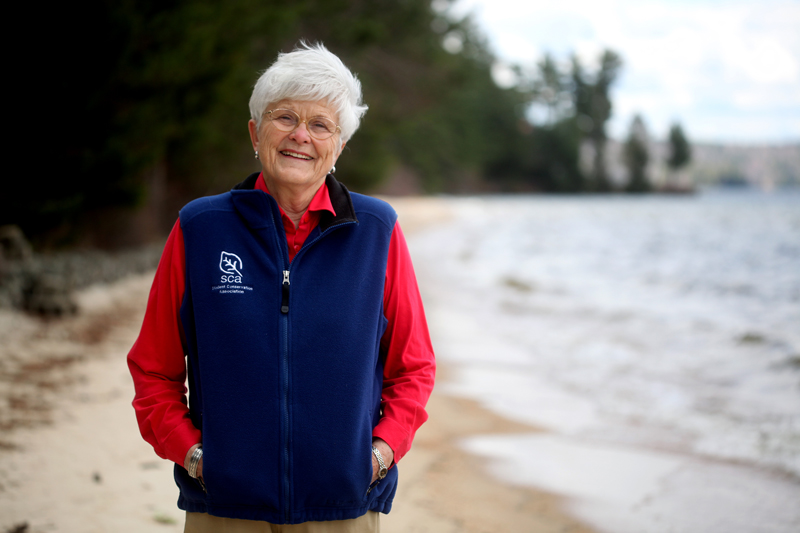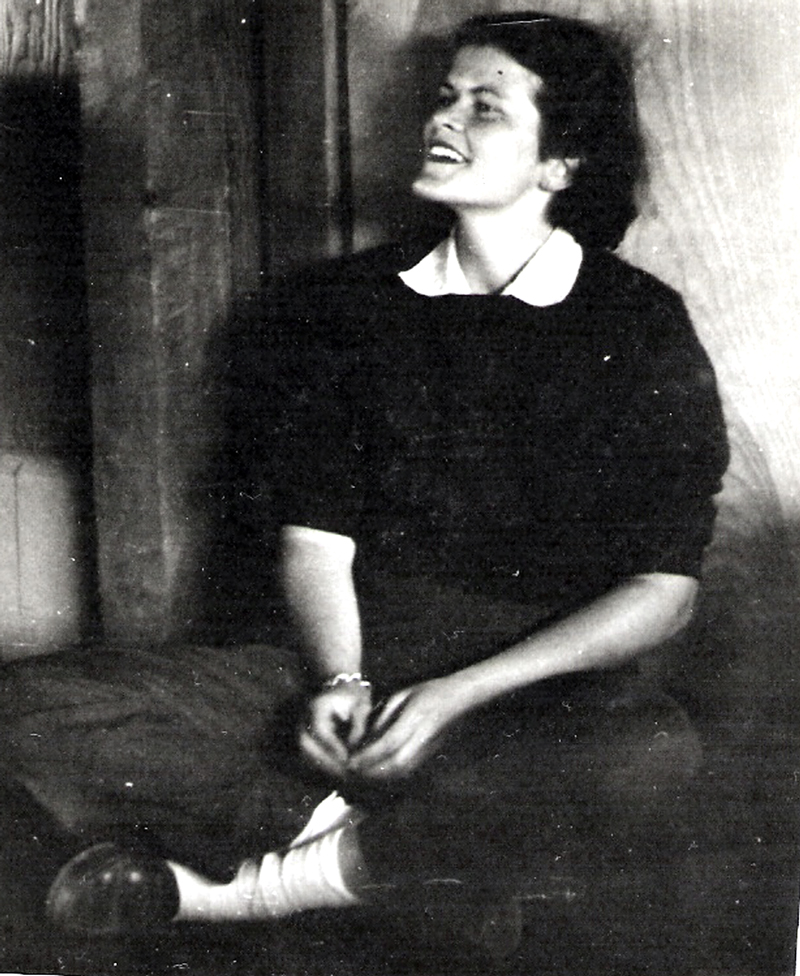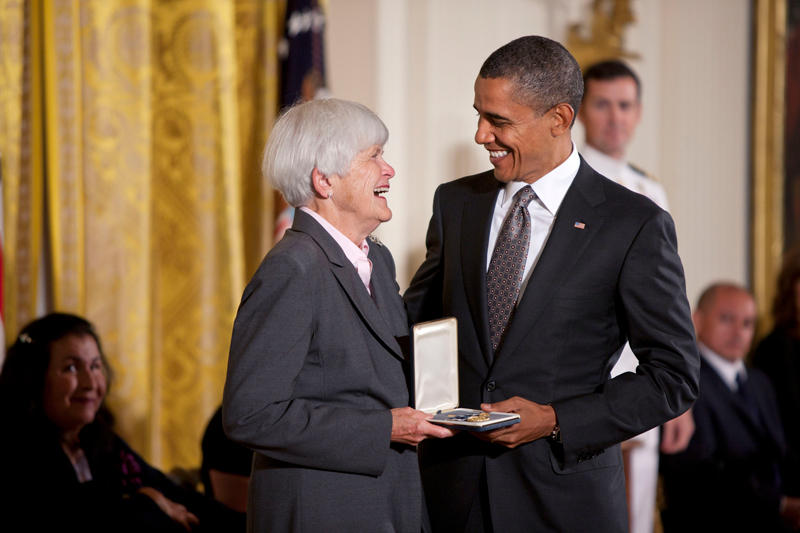The Bennington Garden Club honors the legacy and impact of the Student Conservation Association and its founder, Liz Putnam, through a celebratory event at The Arlington Common
STORY BY BENJAMIN LERNER
PHOTOGRAPHY COURTESY STUDENT CONSERVATION ASSOCIATION
On a clear and sunny afternoon, Liz Putnam is sitting at her dining room table in her home in Southern Vermont. Surrounded by a small group of close friends, she recounts stories of her earliest years as a conservationist with animated zeal. It’s been 65 years since Putnam founded the Student Conservation Association (SCA), but her passion for conservation and environmental advocacy remains as fierce as ever.

As the SCA continues to move forward with its mission of building future generations of conservation leaders, Bennington Garden Club has partnered with the SCA to host a special event. The event is entitled, “Growing the Next Generation of Environmental Stewards: A Celebration of The Student Conservation Association.” It will be held at The Arlington Common on September 28th at 2pm and is free and open to the public. The event will highlight the transformative power of teamwork for conservation, and will also serve as a celebration of the SCA and its continuing impact. It will feature presentations by Kevin Hamilton, SCA’s VP of Communications, and Donald Campbell, the Southern Regional Director of the Vermont Land Trust. In the weeks leading up to the event, we at Stratton Magazine had the privilege of sitting down with Putnam and her friends to discuss the chain of events that led to the founding of SCA, Putnam’s ties to Vermont, the Bennington Garden Club, and the Garden Club of America.
Lessons from Vermont
Nearly a decade before the SCA first came into existence, Liz Putnam learned valuable lessons about the importance of teamwork by working at her family’s farm in Southern Vermont. Putnam came to the Green Mountain State when her family moved here in 1951. It was initially her senior year in high school, and then, her freshman year at Vassar College. She remembers working on her family’s fields with the aid and support of their farming neighbors, the County Agent and Forester, and representatives of other agencies that help Vermonters with their forests and farms. The land had been left in poor shape by the previous owners. Her family had not been farmers, but they wanted to learn. They had to adapt quickly, and they accepted the wonderful help that was offered. Large rocks and boulders had to be removed. They were either buried deeply in the fields, blown up, or added to the surrounding stone walls. In addition to hay, corn was planted in one field, but the rows needed to be weeded. The family was loaned a team of horses that pulled an antique cultivator machine. Putnam drove the team of horses, and she learned how to use the cultivator in the process. She was not strong enough to lift the lever controlling the cultivator by hand, so she would stop the horses at the end of every row and lift the cultivator up by jumping off of the back of the machine while holding onto the lever. She would then get back on the machine, turn the horses to the next row, drop the blade, and continue the process until all of the corn was cultivated. “I learned so much during that time,” says Putnam, “including the value of teamwork. When something needs to be done, it’s important to pitch in and help! It can be good fun—and very satisfying.”
The humble, hardworking, and persistent values that were instilled in Putnam throughout her lifetime—and certainly at the farm—served her well in her academic journey. In her first year at Vassar College, Putnam enrolled in an interdepartmental course entitled “Conservation of Natural Resources.” Several years later, she read an article in Harper’s Magazine that shed light on the drastic state of National Parks in the United States. “I learned about the horrible conditions that many park rangers were living in,” says Putnam. “Many of them were living in leaky tar paper shacks. The parks were severely lacking in adequate funding and staff.”

After reflecting on how she had personally witnessed the power of teamwork at her family’s farm in Vermont, Putnam realized that student volunteers could help the beleaguered park rangers to rehabilitate and maintain the National Parks. “I felt that help was obviously needed. I thought, ‘Why couldn’t students, like myself, pitch in and help?’ Everyone would benefit: students, rangers, and the parks.”
At the time, Putnam was still in the process of deciding her undergraduate major. Although she wanted to write her thesis about the future potential of a student conservation organization, Vassar College did not offer conservation as a major back then. Fortunately, Putnam’s faculty advisor, Dr. A Scott Warthin Jr., was very open-minded. Warthin was a well-loved geology professor who was head of the Geology Department. He helped Putnam navigate the academic system, which helped bring her vision into reality. “Scott shared my dream that an interdepartmental Conservation major would eventually be offered,” said Putnam. “Warthin originally suggested I talk to the heads of the Zoology and Plant Science departments, but they were not as open as he was.” Putnam eventually went back to Scott and told him what had happened. “He said, ‘If you become a geology major, you must develop and complete your thesis and at least 40% of the department’s requirements. The thesis is very important, and you will graduate with a degree in geology.’ Thanks to Scott Warthin, I ended up becoming a Geology major and writing my thesis, ‘A Proposed Student Conservation Corps.’ I have always felt that sometimes, when one door gets shut, another door opens—but you have to look for it and not give up!”
In the summer after her Junior year, Putnam discovered that all geology majors were required to attend a special geology field camp in Wyoming. However, Dr. Warthin discovered that the summer camp was full, so he set up a special opportunity for Putnam to assist a still-forming conservation membership organization: The Upper Hoosick Valley Watershed Association. At the time, the Watershed Association was in the process of getting established in and around Williamstown, Massachusetts, which was just over the state border from Putnam’s house in Vermont. “It turned out to be the perfect opportunity for me,” says Putnam. “I learned some ideas of how to set up a new organization—and also some ideas of what not to do.”
Putnam learned a great deal about effective community outreach and organizational structure during her time at the Upper Hoosick Valley Watershed Association. Furthermore, she was invited to Washington, D.C. to attend the first annual National Watershed Conference. While there, Putnam met Fred M. Packard, Executive Secretary of the National Parks Association. She also met with several Park Service employees at the Department of Interior, who had learned about her thesis and were very interested in the concept. Less than a month later, Putnam was introduced to Bertha E. McPherson, the daughter of Stephen Mather, the founder of the National Park Service (NPS). McPherson was intrigued by Putnam’s thesis, and set up a meeting between Putnam and Horace M. Albright, the former Director of the NPS. Albright was equally impressed with Putnam’s thesis, and he advised her to visit several National Parks, meet with their staff, and discuss the idea during the summer after she graduated from college. He suggested that she visit Olympic, Mt. Rainier, Yellowstone, and Grand Teton National Parks. He gave her a letter of recommendation, sent her on her way, and the rest is history.
After graduating from Vassar College in the Spring of 1955, Putnam asked a college friend, Martha Hayne (Talbot)– who was highly recommended by Dr. Warthin—to join her. Together, they journeyed to the four National Parks in Washington and Wyoming, as suggest- ed by Albright. Their meetings with park staff, including the superintendents, were incredibly productive. They led to the eventual creation of the first of SCA’s student volunteer programs, which were attended by 31 high school-aged boys and 22 college and graduate students. The programs took place at both Olympic and Grand Teton National Parks in the summer of 1957, and the other two parks joined soon after. From there, SCA continued to grow and prosper as an or- ganization and was officially incorporated in 1964.
SCA, GCA, and BGC: A Blossoming Partnership
Thanks to Putnam’s resourceful leadership and the continued teamwork of SCA’s staff, Board of Directors, participants, federal, state, and local agencies, SCA has grown into one of the largest conservation corps in the United States. Putnam’s work has been celebrated through a number of high-profile accolades, including a Chevron Texaco Conservation Award, an Outstanding Achievement Award from the Society of Women Geographers, and the Presidential Citizens Medal, which was awarded to her by former U.S. President Barack Obama in 2011. (Putnam was the first conservationist to have ever received a Presidential Citizens Medal.) Over the past six-and-a-half decades, SCA has facilitated a wide range of conservation programs for young adults, college students, and graduate students. SCA’s programs have enabled over 100,000 participants from all 50 states to develop critical leadership skills through hands-on work in national parks, marine sanctuaries, and community green spaces.
According to SCA’s Vice President of Communications, Kevin Hamilton, SCA’s programs have evolved over the years to meet the ever-changing needs of public parks, forests, and urban communities across the United States. Hamilton elaborates: “Invasive species have become a massive problem everywhere. To that end, about a quarter of the work that we do now is focused on getting rid of invasive species on federal lands. We have also expanded from federal lands to work in almost a dozen cities across the country. Back in the 1960s, Liz Putnam already knew that it was important to reach out to underserved and underrepresented communities. The way that we see it, if you’re given the opportunity to work in your own community to help with the local parks, you are also able to raise the quality of life in that community.”

SCA has also built symbiotic relationships with numerous private and public organizations and institutions, including the Garden Club of America (GCA). GCA has provided a considerable amount of financial support to SCA, and members of GCA’s garden clubs have worked hand-in-hand with SCA members on numerous initiatives, such as trail building projects, invasive plant removal campaigns, and habitat improvement projects, among others. In addition to being the Founding President of the SCA, Putnam is also a longtime member of the only GCA Garden Club in Vermont: the Bennington Garden Club. Founded in 1925 and admitted to the GCA in 1928, the Bennington Garden Club (BGC) works to promote and support horticulture and conservation in the surrounding community. The connections that Putnam formed through the BGC helped her to expand her professional network during SCA’s nascent stages. They also laid the foundation for the invaluable collaborative partnership that still exists between the SCA and the GCA.
According to Putnam, she first became involved with the BGC in 1956. Putnam recalls: “After Marty and I learned that we would be having the first student conservation program participants in Grand Teton National Park and in Olympic National Park, we were thrilled!” At that time, Putnam’s mother was the Conservation Chairman of the BGC. “My mother asked me if Marty and I would give a presentation to the Bennington Garden Club about the proposed program for the following summer,” says Putnam. “After we gave the presentation, members of the BGC were thrilled. They made it possible for us to meet with the officers of the GCA, feeling that they, too, would be interested in the work that we were doing.”
As a result of their presentation, Putnam and Talbot were invited to speak at the GCA Conservation Committee meeting in New York City two days later. “I remember our meeting with a group of very interested women,” says Putnam. “We shared with them about the various programs that would be taking place the following summer at both Grand Teton and Olympic National Parks. We also shared that we were looking for sponsoring organizations to help with fundraising and promotion. They told us that they were very interested, and GCA ended up becoming a sponsor. Putnam was able to meet the heads of other environmental organizations, such as the Sierra Club, National Audubon, and others. As a result, more organizations became interested, and continued to promote the work that SCA was doing. Putnam adds: “GCA was extraordinarily helpful. I am very grateful to the many people who believe in our young people and all that can be accomplished.”
Liz Putnam became an official member of the BGC in 1974. As a resident of Vermont, Putnam remains an active member to this day. She is thankful to be part of an organization that is dedicated to conservation and environmental stewardship, as are long-standing BGC members Polly Jones (Co-President), Joyce Hall (Co-President), Consie West (Conservation Chairman), and Judy Cotter (Program Chairman). In addition to participating in local conservation and horticulture projects, BGC Members also educate community members on environmental issues. In line with the founding values of the SCA, BGC has started to support educational horticulture programs for students who are interested in protecting the environment through the BGC Education Fund. “Through the Education Fund, we support projects, programs, and local nonprofit organizations that help to teach kids about horticulture and about the preservation of the natural world,” says Polly Jones. “The program is very important to us, because it furthers our mission of conservation by educating the next generation.”
Joyce Hall adds that the educational initiatives that are sponsored by BGC’s Education Fund play a significant role in shaping the perspective of future conservationists. “When kids get outdoors, take some time away from their screens, and get their hands in the dirt, they have a greater appreciation for their surrounding environment. When you’re actively involved in conservation, you can see that we all play a part in helping to keep our world beautiful. It inspires us to play a more active role in protecting the world around us.”
BGC also partners with numerous celebrated local institutions and organizations to host events and workshops. In addition to the upcoming event at the Arlington Common, the BGC is hosting an “Advocating for the Environment” event at Bennington College on October 12th at 2PM. The event is open to the public, and speakers include Vermont State Senator Brian Campion and Lauren Hierl, the Executive Director of Vermont Conservation Voters. “Our events showcase what the BGC is all about,” says Judy Cotter. “We’re doing much more than just beautifying the area through our horticulture projects. We are actively supporting conservation efforts, educating the public about conservation, and working to encourage the next generation to make a difference in the future of their natural environment.”
ALL THE DETAILS

